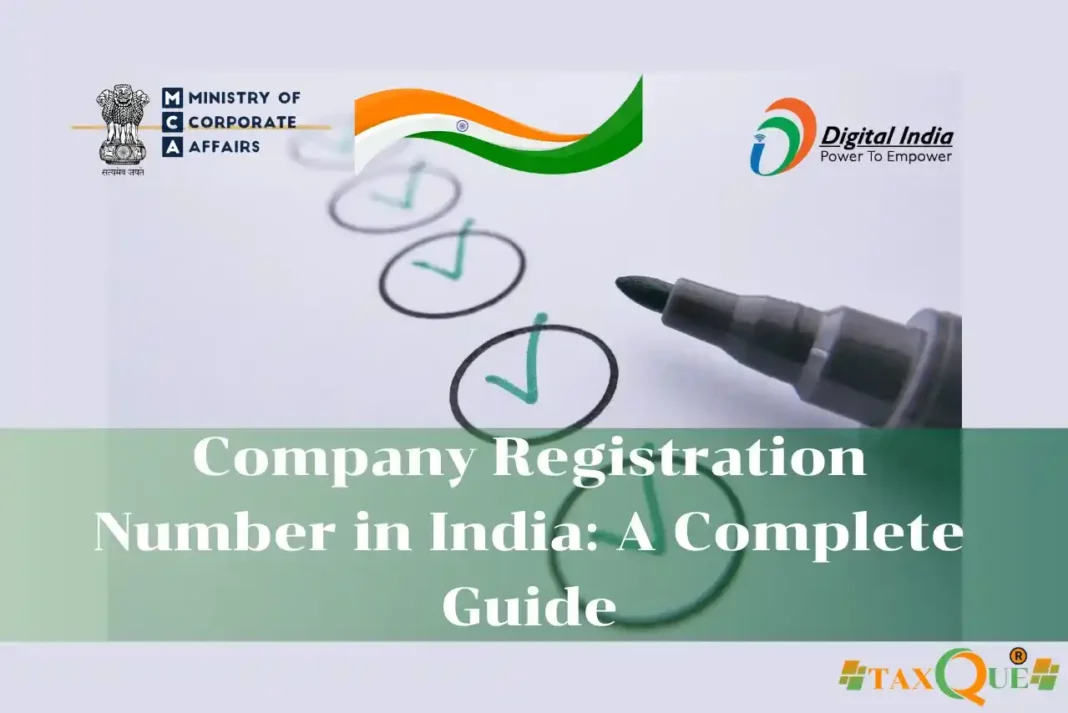Introduction
The company registration number, known as the Corporate Identification Number (CIN) in India, is a unique 21-digit alphanumeric code assigned to companies registered under the Companies Act, 2013. It serves as a legal identifier for private limited, Section 8, Nidhi, or other companies, ensuring transparency and compliance. This blog provides a comprehensive guide on the company registration number, explaining its structure, how to obtain and verify it, and its role in compliance, with insights on how TaxQue simplifies the process.
What Is a Company Registration Number?
The company registration number (CIN) is issued by the Registrar of Companies (ROC) under the Ministry of Corporate Affairs (MCA) upon company incorporation. It uniquely identifies a company’s registration details, including its type, state, and incorporation year. The CIN is essential for regulatory filings, compliance checks, and stakeholder verification, making it a cornerstone of corporate governance.
1. Structure of the Company Registration Number
The company registration number (CIN) comprises 21 digits, broken down as:
- First Character: Listing status (L for listed, U for unlisted).
- Next 5 Digits: Industry code (e.g., 67120 for Nidhi companies).
- Next 2 Characters: State code (e.g., MH for Maharashtra).
- Next 4 Digits: Year of incorporation (e.g., 2025).
- Next 3 Characters: Company type (e.g., PTC for private limited, NPL for Section 8).
- Last 6 Digits: ROC registration number (e.g., 123456).
Example: U67120MH2025PTC123456 (unlisted private limited company in Maharashtra, incorporated in 2025).
2. How to Obtain a Company Registration Number
Obtaining a company registration number is part of the company incorporation process:
| Step | Task | Timeline |
|---|---|---|
| Obtain DSC | Secure Digital Signature Certificate for directors | 1–2 days |
| Apply for DIN | Obtain Director Identification Number | 1–2 days |
| Reserve Name (RUN) | Reserve unique company name via SPICe+ | 2–3 days |
| File SPICe+ (INC-32) | Submit incorporation forms, MoA, AoA | 5–7 days |
| Receive CIN | Obtain Certificate of Incorporation with CIN | Post-approval |
- Step 1: Get DSC and DIN: Directors need a Class 3 DSC for e-signing and DIN via SPICe+ (Form INC-32) on the MCA portal.
- Step 2: Reserve Name: Use SPICe+ Part A (RUN) to reserve a name (e.g., “Nidhi Limited” for Nidhi companies).
- Step 3: File SPICe+: Submit SPICe+ Part B with MoA, AoA, and director details (PAN, Aadhaar, address proof).
- Step 4: Receive CIN: Post-approval (5–7 days), the ROC issues the Certificate of Incorporation with the CIN, PAN, and TAN.
- Nidhi/Section 8: File Form NDH-4 (Nidhi status) or INC-12 (Section 8 license) before or after SPICe+.
3. How to Verify a Company Registration Number
To check company registration number (CIN) and ensure compliance:
- MCA Portal: Visit MCA portal, select “MCA Services” > “View Company/LLP Master Data,” and enter the CIN. Verify:
- Company name, status (Active, Struck Off).
- Registered office, incorporation date.
- ROC filings (AOC-4, MGT-7 for private companies; NDH-1 for Nidhi).
- Director Details: Use “View Director Master Data” with DIN to check director status.
- Tax Compliance: Verify PAN/TAN on the Income Tax portal and GSTIN on the GST portal.
- Nidhi/Section 8: Confirm NDH-4 (Nidhi) or 12A/80G (Section 8) status on MCA or Income Tax portals.
4. Post-Registration Compliances Using CIN
The company registration number is required for ongoing compliances:
- ROC Filings: File Form AOC-4 (financials) by October 30 and MGT-7 (annual return) by November 29 post-AGM, quoting the CIN.
- Tax Filings: Submit ITR-6 (private/Nidhi) or ITR-7 (Section 8) by October 31; GSTR-9 by December 31 (if GST-registered).
- Nidhi-Specific: File NDH-1 (member list) by June 29 and NDH-3 half-yearly, using CIN.
- Audits and Meetings: Conduct statutory audits and hold 4 board meetings and an AGM by September 30.
- Use TaxQue to manage compliances linked to the company registration number.
5. Penalties for Non-Compliance
Failing to use the company registration number for compliances can lead to:
- Fines: ₹100/day for late ROC filings; ₹5,000 for late ITR; ₹200/day for GST returns.
- Director Disqualification: Barred for 3 years under Section 164.
- Company Dissolution: Struck off by ROC under Section 248.
TaxQue simplifies obtaining and managing the company registration number with support for incorporation, ROC, and tax filings. Visit TaxQue’s company registration guide or compliance services for expert solutions.
FAQs
1. What is a company registration number in India?
The company registration number, or CIN, is a 21-digit code issued by the ROC to identify registered companies.
2. How can I verify a company registration number?
Use the MCA portal’s “View Company/LLP Master Data” feature, enter the CIN, and check registration and compliance details.
3. Is the CIN required for tax filings?
Yes, the CIN is used in ITR-6/7 and GST filings to link the company’s tax records.
4. What happens if a company’s CIN shows “Struck Off”?
A “Struck Off” CIN indicates dissolution due to non-compliance; the company must apply to NCLT for revival.
5. How does TaxQue assist with the company registration number?
TaxQue supports CIN acquisition during incorporation and ensures compliance with ROC and tax filings. Explore TaxQue’s Nidhi compliance guide.
Conclusion
The company registration number (CIN) is a vital identifier for companies in India, enabling legal operations and compliance. From obtaining the CIN during incorporation to verifying it on the MCA portal and using it for ROC, tax, and Nidhi filings, each step ensures transparency. Platforms like TaxQue streamline the company registration number process and ongoing compliances with expert tools. Verify your CIN, stay compliant, and build a trusted business.





